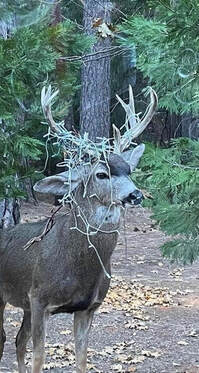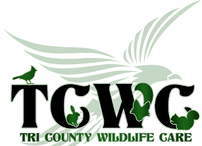Reduce your Holiday Decoration Trash

The end of the year brings many holiday celebrations. Some of our decorations, however, can put wildlife at risk. Try some of the suggestions below to make your celebrations zero waste and safe for the environment and wildlife.
If you buy a live Christmas tree, make sure to compost it when the season is over. As the tree grows, it absorbs carbon from the air. Burning will release greenhouse gases, but composting it puts the nutrients back into the soil. Or choose a live Christmas tree in a pot that you can plant later. If you already have a fake tree, use it again, and again, and again!
Most of us don't send Christmas cards like we once did. But if you are still interested in sending a little cheer through the mail, consider plantable Christmas cards. Send a card, which is embedded with wildflower seeds, and the recipient can plant it after the holidays. The wildflowers will remind them of you for months to come.
If you would like a wreath for your front door or picture window, choose a real, fresh wreath made with natural foliage. Stay away from glittery and plastic decorations for your wreath as these can be dangerous for wildlife. Instead use fresh herbs, dried flowers, pine cones, and for a lovely scent include cinnamon sticks, rosemary and lavender. For the bows, don’t use polyester ribbon. Instead, use wool or cotton yarn or fabric. And again, remember to put the wreath and its decorations in the compost pile when the season is over.
Synthetic garlands and wreaths may look natural, but they are not. If it looks real to you, it might also look real to a bird. If a bird ingests the pretty little plastic red berries, it will have more than an upset tummy. Instead, use mistletoe which is a yummy treat to bluebirds and other winter berry eating birds.
To light up your home or your tree, use LED lights. These use up to 80% less energy, last longer than incandescent lights and cost less to use.
Since deer will rub on anything and can get their antlers tangled up in strings of lights, please attach lights to the house or if in trees, put them above the reach of deer (above six feet). Or wrap lights tightly around posts. Lights draped over small shrubs could endanger animals.
Enjoy your holidays and enjoy the wildlife that surrounds you.
Tri County Wildlife Care, a local nonprofit started in 1994, is dedicated to the rescue and rehabilitation of our native wildlife and helping our community live in balance with wildlife. They envision a world where wildlife and people thrive together. For more information call (209) 283-3245, or visit pawspartners.org
If you buy a live Christmas tree, make sure to compost it when the season is over. As the tree grows, it absorbs carbon from the air. Burning will release greenhouse gases, but composting it puts the nutrients back into the soil. Or choose a live Christmas tree in a pot that you can plant later. If you already have a fake tree, use it again, and again, and again!
Most of us don't send Christmas cards like we once did. But if you are still interested in sending a little cheer through the mail, consider plantable Christmas cards. Send a card, which is embedded with wildflower seeds, and the recipient can plant it after the holidays. The wildflowers will remind them of you for months to come.
If you would like a wreath for your front door or picture window, choose a real, fresh wreath made with natural foliage. Stay away from glittery and plastic decorations for your wreath as these can be dangerous for wildlife. Instead use fresh herbs, dried flowers, pine cones, and for a lovely scent include cinnamon sticks, rosemary and lavender. For the bows, don’t use polyester ribbon. Instead, use wool or cotton yarn or fabric. And again, remember to put the wreath and its decorations in the compost pile when the season is over.
Synthetic garlands and wreaths may look natural, but they are not. If it looks real to you, it might also look real to a bird. If a bird ingests the pretty little plastic red berries, it will have more than an upset tummy. Instead, use mistletoe which is a yummy treat to bluebirds and other winter berry eating birds.
To light up your home or your tree, use LED lights. These use up to 80% less energy, last longer than incandescent lights and cost less to use.
Since deer will rub on anything and can get their antlers tangled up in strings of lights, please attach lights to the house or if in trees, put them above the reach of deer (above six feet). Or wrap lights tightly around posts. Lights draped over small shrubs could endanger animals.
Enjoy your holidays and enjoy the wildlife that surrounds you.
Tri County Wildlife Care, a local nonprofit started in 1994, is dedicated to the rescue and rehabilitation of our native wildlife and helping our community live in balance with wildlife. They envision a world where wildlife and people thrive together. For more information call (209) 283-3245, or visit pawspartners.org

